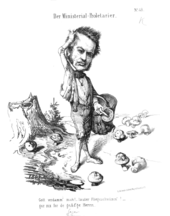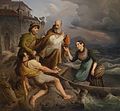Wilhelm Völker
Johann Wilhelm Völker (born December 11, 1811 in Kleinheubach , † December 18, 1873 in St. Gallen ) was a German painter of Biedermeier realism .
Life
origin

Völkers parents were Amalia Christina Wenneiß from Wertheim and Gallus August Völker from Rothenfels who was a clerk in the Löwenstein-Wertheim-Rosenberg house . They had six children together and after their marriage they lived in Wertheim before they moved to Kleinheubach - like their father's employer, Prince Dominik Konstantin . There they lived in the house of the sculptor Nikolaus Laurentius Burger, where Johann Wilhelm Völker was born. He was baptized on December 16, 1811 according to the Protestant and on May 31, 1812 according to the Catholic rite. In 1815 the family moved back to Wertheim and lived there at Mühlenstrasse 34. Völkers mother died there that same year giving birth to her sixth child. The father's second marriage to Apollonia Nebel in 1818 resulted in ten more children.
On January 4, 1845, the son Ernst August Andreas was born, the wedding with the mother Monika Rosalie Christina Hüther took place on October 27 of the same year in the Munich Holy Spirit Church . The daughter Elisabeth followed on August 9, 1846, the son Wilhelm Karl Anton on February 14, 1848, the son Josef Anton on February 11, 1851 and the daughter Karolina on September 29, 1852.
School and education
From Easter 1823 Völker attended grammar school in Kilian's Chapel . He was certified as having "various talents in drawing"; his teacher in drawing was Johann Leonhardt Gottfried Faber (1788–1834). Following his school days, Völker attended the polytechnic school in Munich from September 1827 ; on October 9, 1828, he was accepted as a student in history painting at the Academy of Fine Arts . Prince Karl Thomas zu Löwenstein-Wertheim-Rosenberg and his brother Konstantin , who also lived in Munich, financially supported his education, which ended in 1834.
Work as a cartoonist
Since Völker received no royal commissions, he gave private lessons in drawing and turned to landscape and genre painting . From 1834 he was a member of the Münchner Kunstverein . With a brief interruption, he was a member of the association until 1847. In Munich he also belonged to the artist society Zum Stubbenvoll , which met in the artist's pub of the same name and which included the genre painter Karl von Enhuber and the landscape painter Christian Morgenstern . According to the painter Friedrich Pecht , the meetings were often very wild and noisy . Völker illustrated the story of the great hero and duke Heinrich the Lion , published in 1844, and his wonderful and extremely dangerous journey by Karl Simrock with seven stories and the title page. When the press censorship was lifted at short notice in April 1848, new opportunities arose for the cartoonist. He traveled to Frankfurt , where he made over 30 caricatures of members of parliament and scenes from Paulskirche for Eduard Gustav May's renowned picture publisher . His caricatures, for example Politischer Damenclub , were also published in the magazine Der Satyr , while his more factual works appeared in the Illustrirten Zeitung , which is published in Leipzig . After the failure of the Paulskirche parliament and the new press restrictions that followed, he was unable to publish as many caricatures as before. In June 1848 he traveled to Munich again; in the following year he moved to Kleinheubach. At the court there, Völker worked as a drawing teacher and increasingly turned to religious motifs in his painting, which was also reflected in a number of altarpieces. During this time Völker also worked on his first book, The Art of Painting. Contains the landscape, portrait, genre and history subject according to a purely artistic, easily comprehensible method , which appeared in 1852.
Drawing teacher
Again in Munich at the turn of the year 1852/53 Völker passed the state service examination for teaching qualification, which enabled him to work as a drawing teacher with the rank and salary of a professor in St. Gallen, where the family moved in March 1853. In addition to his work at the grammar school and later the canton school , he wrote on his second work on art theory, analysis and symbolism. Hypotheses from the world of forms , which appeared in 1861. In 1865 he published The Freehand Drawing after Geometric Solids and Gypsum Models .
“The discipline was not the best with the drawing teacher Wilhelm Völker, one of the most peculiar figures in our school history. His unmethodical teaching, his one-sided promotion of talented draftsmen, his quick-tempered temperament and his comically rushing violence in anger provoked the students to contradict and deliberately conjure up scenes that brought amusing changes to the monotony of the day. But besides that, Völker was a real artist and a philosopher, who gave the more mature pupils who came closer to him an abundance of suggestions. "
Völker died of a heart attack at the age of 62. The fate of his family, who remained penniless, led to the establishment of the independent widows, orphans and retirement fund of the cantonal school teachers .
The Kunstverein in Carlsruhe had loud Nagler before 1850 the picture in severe weather warn you Überfuhr bought. The Munich City Museum had loud Thieme-Becker (1926) Drawings Völkers in his Maillingerstraße Collection .
Works (selection)
Löwenstein Castle in Kleinheubach (1851)
- Evening peace (in the holdings of the Grafschaftsmuseum Wertheim)
- The murder of Prince Lichnowsky and General von Auerswald zu Frankfurt a. M. on September 18, 1848
- Altarpieces of St. Venantius and Our Lady in the St. Venantius Church in Wertheim (1852)
- Descent from the Cross (1871, Palais of the Bishop of St. Gallen)
Fonts
- The art of painting. Contains the landscape, portrait, genre and history subject according to a purely artistic, easily comprehensible method. Rudolf Weigel, Leipzig 1852
- Analysis and symbolism. Hypotheses from the world of forms , Leipzig, 1861
- Freehand drawing based on geometrical bodies and gypsum models , 1865
literature
- Völker, Wilhelm (Johann W.) . In: Hans Vollmer (Hrsg.): General lexicon of fine artists from antiquity to the present . Founded by Ulrich Thieme and Felix Becker . tape 34 : Urliens – Vzal . EA Seemann, Leipzig 1940, p. 468 .
- Völker, Johann Wilhelm. In: Sikart
- Georg Kaspar Nagler : New general artist lexicon or news from the life and works of painters, sculptors, builders, engravers, form cutters, lithographers, draftsmen, medalists, ivory workers, etc. Volume 20, p. 477, Fleischmann, Munich 1850 ( dfg-viewer.de ).
- Völker, Wilhelm or Johann Wilhelm. In: Emmanuel Bénézit : Dictionary of Artists. Volume 14. Gründ, Paris 2006, ISBN 2-7000-3084-2 , p. 450.
- Marion Diehm: "With longing for the hometown ..." . In: Main-Echo Special for the Michaelis-Messe Wertheim 2011 from September 2011
Web links
Individual evidence
| personal data | |
|---|---|
| SURNAME | Völker, Wilhelm |
| ALTERNATIVE NAMES | Völker, Johann Wilhelm (full name) |
| BRIEF DESCRIPTION | German painter |
| DATE OF BIRTH | December 11, 1811 |
| PLACE OF BIRTH | Kleinheubach |
| DATE OF DEATH | December 18, 1873 |
| Place of death | St. Gallen |









